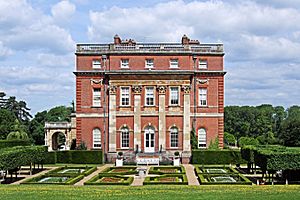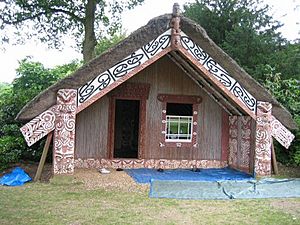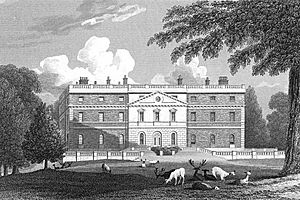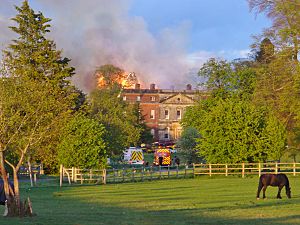Clandon Park House facts for kids
Quick facts for kids Clandon Park House |
|
|---|---|

The south front and parterre of Clandon Park House in 2014, a year before the fire
|
|
| Type | Country house |
| Location | West Clandon, Surrey |
| OS grid reference | TQ 04210 51218 |
| Built | Early 18th Century |
| Architect | Giacomo Leoni |
| Architectural style(s) | Palladian |
| Owner | National Trust |
|
Listed Building – Grade I
|
|
| Official name: Clandon Park | |
| Designated | 14 June 1967 |
| Reference no. | 1294591 |
| Lua error in Module:Location_map at line 420: attempt to index field 'wikibase' (a nil value). | |
Clandon Park House is a beautiful old mansion in West Clandon, near Guildford in Surrey, England. It was built in the early 1700s in a grand style called Palladian architecture. This means it was designed to look like old Roman buildings, with lots of symmetry and classical details.
The house sits in a large park called Clandon Park, which is about 220 hectares (540 acres) big. For over 200 years, it was the home of the Earls of Onslow, a noble family. In 1956, the house and its gardens were given to the National Trust, a charity that looks after historic places. However, the parkland around the house is still privately owned.
An Italian architect named Giacomo Leoni designed Clandon Park House, and building started around 1730. The inside was decorated by skilled artists from Europe in the 1740s. Later, in 1781, the famous landscape designer Lancelot 'Capability' Brown created the beautiful parkland. You can still see the fancy iron gates and gatehouses he designed leading to the park.
Near the house, there's a special Māori meeting house from New Zealand. It's one of only a few outside its home country. Clandon Park House was once a popular place for weddings and even for filming historical TV shows and movies.
Sadly, in April 2015, a huge fire badly damaged Clandon Park House. It was probably caused by an electrical problem in the basement. Most of the house was destroyed, leaving it "essentially a shell," with only one room, the Speaker's Parlour, still intact. Thousands of old items, paintings, and furniture were lost. The National Trust is now working to restore parts of the house and make it safe for visitors again.
Contents
History of Clandon Park House
The land and an older house on this spot were bought in 1641 by Sir Richard Onslow. He was a Member of Parliament (MP) and a very important person at the time. His great-grandson, Thomas Onslow, 2nd Baron Onslow, later decided to build the grand house we know today.
Many members of the Onslow family were involved in politics. Three of them, including Arthur Onslow, became Speakers of the House of Commons. This is a very important job in the British government. Their portraits used to hang in the Speaker's Parlour at Clandon House.
The current Clandon Park House was built between 1730 and 1733. It was designed by the Venetian architect Giacomo Leoni. The house is made of red brick with stone decorations. Inside, the rooms were finished in the 1740s. The Marble Hall was a highlight, with beautiful marble fireplaces and a fancy plaster ceiling created by Italian-Swiss artists.
The park around the house was redesigned by Lancelot 'Capability' Brown between 1776 and 1781. He changed an old French garden and turned a disused canal into a pretty lake. Later, in the late 1800s, a special sunken garden was added. During World War I, the Onslow family even turned Clandon House into a hospital for injured soldiers.
How the House Was Built
It's important to know that some of the money used to build Clandon Park House came from activities linked to slavery. Elizabeth Knight, who married into the Onslow family, inherited her wealth from her uncle, Charles Knight. Charles was involved in the slave trade and owned sugar plantations in Jamaica. These plantations relied on the forced labor of enslaved people.
Elizabeth inherited one of these plantations and the enslaved workers who were forced to work there. Her husband, Thomas Onslow, also started a company that insured slave ships. The ownership of these slave plantations stayed in the Onslow family for many generations. At different times, between 87 and 150 enslaved people were held captive and forced to work on these plantations.
Becoming a National Trust Property
In 1945, William Onslow, 6th Earl of Onslow, inherited Clandon House. During World War II, the family had moved out so the house could be used to protect government documents from bombs. In 1956, the Earl decided to give Clandon House to the nation.
The National Trust agreed to take the house, but they needed money to help look after it. So, the Earl's aunt, Gwendolen, Countess Iveagh, bought the house from the Onslows for a very small amount (£1). Then, she donated Clandon House, along with some land and the Māori meeting house, to the National Trust.
When the National Trust took over, the house was not in great condition. Many of its grand rooms were almost empty. However, the Trust received many paintings, furniture, and other valuable items from the Onslow family and other donors, like Hannah Gubbay.
Life at Clandon Park (1968 – 2014)
Between 1968 and 1970, Clandon Park House was carefully restored and redecorated. The goal was to bring back the feeling of the 18th century. Many new items were brought in from the National Trust's collections, and some old antiques connected to the house were bought back.
By the 2000s, the house was filled with beautiful things, including a collection of porcelain figures, old tapestries, and rich carpets. Because it cost a lot to maintain, the National Trust started using it as a wedding venue, which became very popular. The house was also sometimes rented out for filming. For example, parts of the movie The Duchess, starring Keira Knightley, were filmed there in 2008.
The 2015 Fire
On the afternoon of April 29, 2015, a fire started in the basement of Clandon Park House. It quickly spread to the roof. Firefighters arrived quickly, with over 80 people working to put out the blaze. While they fought the fire, volunteers and experts from the National Trust worked hard to save furniture and artworks. They wrapped items in bubble wrap and moved them to a safe storage place. About 600 important items were saved.
The fire caused terrible damage. The roof, ceilings, and floors collapsed into the basement. Only one room, the Speaker's Parlour, remained mostly untouched. Many historic items were lost, including a football that was kicked across no-man's land during the Battle of the Somme in World War I. Luckily, some valuable paintings and furniture were saved, including a large portrait of Richard Onslow, 1st Baron Onslow. An official investigation found that the fire was most likely caused by a fault in an electrical box in the basement.
Restoration Plans
After the fire, the National Trust announced plans to restore Clandon Park House. In January 2016, they said they would bring back some of the main rooms on the ground floor to look like they did in the 1700s. The upper floors, which were less important historically, would be made modern for exhibitions and events. The cost of this restoration was expected to be around £65 million, covered by insurance.
However, the plans changed over time. In 2022, the National Trust announced a new approach. Instead of fully restoring many rooms, they decided to focus on the Speaker's Parlour (the only room that survived the fire intact). They also plan to restore the outside walls, the roof, and the windows. The rest of the house will be kept in its ruined state but made safe and accessible to the public. New walkways will be built so visitors can see how an 18th-century house was constructed. There might even be a new rooftop terrace with views of the countryside.
Maori Meeting House

In the gardens of Clandon Park, there is a special Māori meeting house called Hinemihi. This building originally stood near Lake Tarawera in New Zealand. In 1886, it provided shelter to the people of Te Wairoa village during a volcanic eruption. The building was covered in ash, but the people inside survived.
In 1892, William Onslow, 4th Earl of Onslow, who was then the Governor General of New Zealand, bought Hinemihi. He had it restored and shipped all the way to England. Today, there are only three other Māori meeting houses outside of New Zealand.
The National Trust has worked to repair and look after Hinemihi. They replaced the roof and cleaned its beautiful carvings. This meeting house is still very important for cultural activities among the Māori people, especially those living in London.
Surrey Infantry Museum
Before the fire, Clandon House was also home to the Surrey Infantry Museum. This museum opened in 1981 and displayed many items related to the Queen's Royal Surrey Regiment. Visitors could see old uniforms, medals, weapons, and photographs.
In 2011, the museum merged with others to become the Surrey Infantry Museum. It had a collection of six Victoria Crosses, which are the highest military awards for bravery. Sadly, the museum was located in the basement of Clandon House and was completely destroyed in the 2015 fire.




